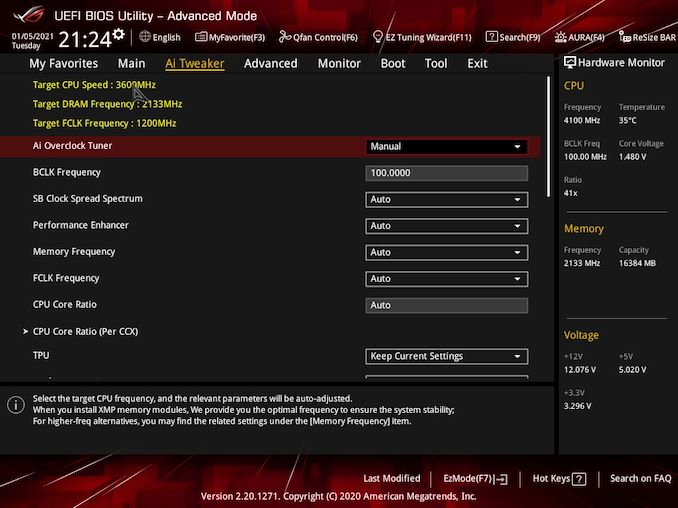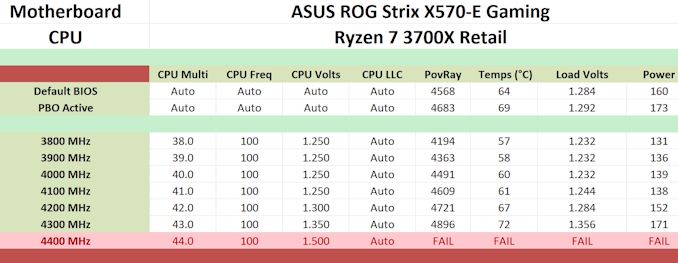The ASUS ROG Strix X570-E Gaming Motherboard Review
by Gavin Bonshor on January 25, 2021 11:00 AM EST- Posted in
- Motherboards
- AMD
- Asus
- ROG
- AM4
- Ryzen 3000
- X570
- Strix X570-E
- Ryzen 5000
- X570-E Gaming
Overclocking Ryzen 3000
Experience with the ASUS ROG Strix X570-E Gaming
Despite AMD's Ryzen 5000's presence on the current market and with support for these across various AM4 chipsets, we do all of our AM4 testing with the Ryzen 7 3700X processor for consistency. Overclocking can yield many benefits in performance, but at the drawback of extra heat and power. This is a consequence of adding more CPU VCore.
Most power delivery is over-engineered to support the latest processors, however hot they run. This is a continuance of CPU vendors constantly pushing default and turbo clocks, pushing the silicon to its limits. Anyone looking to overclock will need to consider more aggressive cooling types such as large premium AIOs.
Using the ASUS ROG Strix X570-E Gaming for overclocking, the firmware itself is user-friendly and benefits from a consistent design throughout. All of the board's overclocking settings can be found in the Ai Tweaker section of the Advanced mode, which can be accessed by pressing the F7 key. Overclocking the CPU is easy to do which can be done as easily as altering the CPU Core Ration and CPU VCore voltage. For more in-depth overclocking and tweaking, ASUS includes base clock (BCLK) control which not only overclocks the CPU but the memory too.
Touching on memory overclocking, ASUS includes a wide variety of customizable memory latencies for fine-tuning. Users can enable X.M.P 2.0 profiles on memory with built-in profiles, although ASUS for its AMD models calls this D.O.C.P or Direct Over Clock Profile. This is just ASUS's fancy way of saying X.M.P. AMD recommends a maximum FCLK (Infinity Fabric Clock) of 1800 MHz, which ties in with what DDR4-3600 memory in a 2:1 ratio. This is AMD's recommended sweet spot for the best memory performance.
Overclocking Methodology
Our standard overclocking methodology is as follows. We select the automatic overclock options and test for stability with POV-Ray and OCCT to simulate high-end workloads. These stability tests aim to catch any immediate causes for memory or CPU errors.
For manual overclocks, based on the information gathered from the previous testing, start off at a nominal voltage and CPU multiplier, and the multiplier is increased until the stability tests are failed. The CPU voltage is increased gradually until the stability tests are passed. The process is repeated until the motherboard reduces the multiplier automatically (due to safety protocol) or the CPU temperature reaches a stupidly high level (105ºC+). Our testbed is not in a case, which should push overclocks higher with fresher (cooler) air.
We overclock with the Ryzen 7 3700X for consistency with our previous overclocking tests.
Overclocking Results
The ASUS ROG Strix X570-E Gaming performs very competitively against some of the best AM4 boards we have tested. At default settings, the board is using conservative CPU VCore levels at full load, with slightly higher CPU VCore with PBO active. Despite including an enabled mode, the default profile does include elements of PBO with little operating both profiles in POV-Ray performance.
In our manual testing in increments of 100 MHz from 3.8 to 4.3 GHz, we saw an increase in POV-Ray performance throughout our testing. Along with the increase in CPU VCore from 4.1 to 4.2 and beyond, this brought extra temperatures and power, but not enough to cause too much of a negative effect.
The VDroop control when using the default load-line calibration settings is also tight, with the CPU VCore under volting throughout the majority of our testing, with slight overcompensation when testing at 4.3 GHz. Overall the ASUS ROG Strix X570-E Gaming is a capable performance in our overclock testing.












46 Comments
View All Comments
Spunjji - Tuesday, January 26, 2021 - link
In defence of the author, testing at multiple RAM settings takes a lot of time, and deciding which RAM settings to test at is a how-long-is-a-piece-of-string question.You hit a disanalogy on a bunch of those - most users don't use POV-Ray, but they need a broad spread of benchmarks to be used repeatably for each review and those benchmarks have to be *something*. RAM speed is variable for every CPU and motherboard combo tested - it adds substantially to test time, and can potentially cause issues if a given board / CPU doesn't support the same speeds and timings as others from that range.
LakshanVC - Tuesday, January 26, 2021 - link
Asus rog strix x570 E, This motherboard, or msi thomhawk x570 motherboard. Which of the two is better?Monty_Python - Tuesday, January 26, 2021 - link
Does that heatsink cause any issues with PCI Gen 4 SSDs like the Corsair MP600?Knightworld - Wednesday, January 27, 2021 - link
This is a pretty old of MoBo. This review is quite late my friend.alex_silva - Thursday, February 25, 2021 - link
my favorite board in terms of I/O, features, wifi, and msrp price.worldnewsnow - Friday, March 12, 2021 - link
https://worldnewsera.com/https://worldnewsera.com/shop/
https://worldnewsera.com/news/
https://worldnewsera.com/news/us-news/